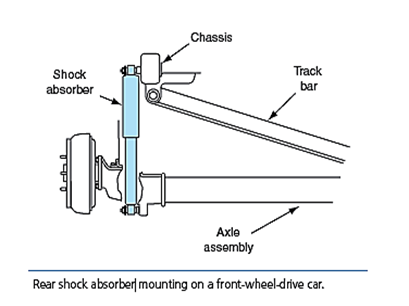←
Automobile Engineering
Shock Absorber Ratios
Introduction:
Most automotive shock absorbers are a double-acting-type that controls spring action during jounce and rebound wheel movements. A shock absorber is mounted between the rear axle and the chassis on a front-wheel-drive car.
Rear shock absorber

- The piston and valves in many shock absorbers are designed to provide more extension control than compression control.
- An average shock absorber may have 70 percent of the total control on the extension cycle, and thus 30 percent of the total control is on the compression cycle.
- Shock absorbers usually have this type of design because they must control the heavier sprung body weight on the extension cycle.
- The lighter unsprung axle, wheel, and tire weight are controlled by the shock absorber on the compression cycle.
- A shock absorber with this type of design is referred to as a 70/30 type. Shock absorber ratios vary from 50/50 to 80/20.
- A shock absorber is mounted between the rear axle and the chassis on a front-wheel-drive car. Mounting bolts extend through hangers on the rear axle and chassis.
- These bolts also pass through the isolating bushings on each of the shock absorbers.
- The isolating bushings are very important for preventing vibration and noise.
- Front shock absorbers may be mounted in a similar way between the lower control arms and the chassis.